Prominent Scientists Declare “All Non Human Animals… Are
Conscious Beings.”
The Dalai Lama Protests Chicken
Slaughter. An Orangutan Won Non-Human Rights Over Zoo Keeper.
What Do the Teachers Say About
Non-Human Compassion?
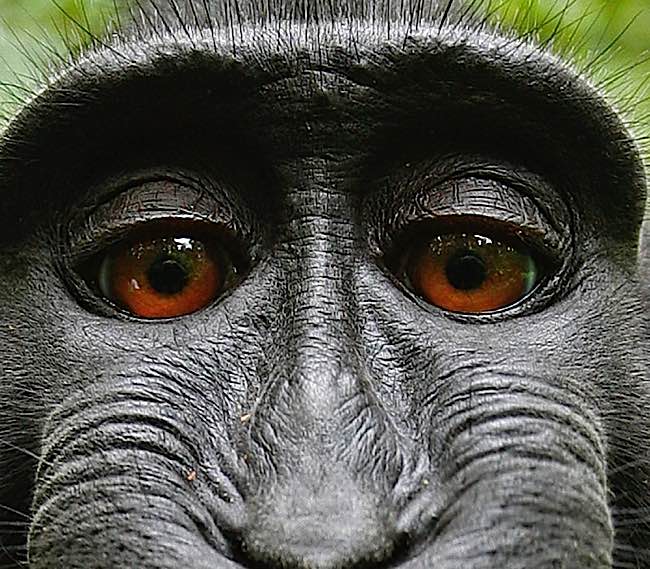
Recently,
a monkey won the rights to a selfie photo over the owner of the camera.
The advance in non-human rights begs the question, from a Buddhist perspective, when we promise to liberate all sentient beings — or not to kill — just who do we include? If our definition includes all beings down to insects and octopuses, how do we reconcile our dependence on “lower” beings for survival?
Increasingly, teachers are speaking out on non-human sentience and unnecessary suffering for these beings. When the Dalai Lama famously protested “cruelty to chickens” in 2012, it was inspired by an abundance of compassion (see “Dalai Lama and Chickens” below). How does the “Cambridge Declaration” from an international group of prominent scientists, stating that even octopuses feel emotions, change our view? More importantly, what do our teacher’s say? To help provide insight, we collected teachings from the Buddha, the Dalai Lama, Bikkhu Bodhi, Thich Nhat Hanh, Zasep Tulku Rinpoche, Karma Lekshe Tsomo, Lama Zopa Rinpoche, Kyabje Chatral Sangye Rinpoche, Geshe Thubten Soepa, and, of course, Stephen Hawking and the Cambridge Scientists.

Teachers
such as the Dalai Lama (centre) and Lama Zopa Rinpoche (right) teach compassion
to non-humans and promote vegetarianism. Left, Ani Ngawang Samten.
Buddha: First Precept
“Abstain from Taking Life”
The Buddha’s first precept in Pali reads: “Panatipata verami sikkhapadam samadiyami” which translates more-or-less as: “I undertake the training rule to abstain from taking life.” For many, this meant human life. For others, particularly Zen Buddhists, it meant any breathing creature.

Japanese
monk shares a tender moment with a non-human. Zen and Mahayana Buddhists
particularly avoid meat.
Cambridge
Declaration: “Human’s not unique in possessing … consciousness.”
The scientists demonstrated that emotions and decision-making develop in all life forms down to cephalopod mollusks. Even Steven Hawking and other giants endorsed the declaration, titled “The Cambridge Declaration on Consciousness.” Issued by a prominent group of neurophysiologists, neuroanatomists, cognitive neuroscientists, neuropharmacologists and computational neuroscientists — this statement leaves little wiggle room for diminishing levels of compassion for “lower” life forms. [To read the full declaration, the PDF is available for download here>>] (View the video from Stephen Hawking on the sentience of lower animals, embedded below)
Stephen Hawking and Non-Human Consciousness
On the heels of this declaration, an orangutan in an Argentinian zoo won non-human personhood rights in a fight to determine if it had been unlawfully deprived of it’s freedom. Also, the credit for the “selfie” at the top of our feature is under legal review to determine whether the monkey or the owner of the camera deserved the credit. [7]

The
Dalai Lama protested chicken cruelty and slaughter by a major food franchise.
Dalai Lama’s “Cruelty
to Chickens” Letter
At the time, PETA proclaimed that chickens “feel pain and have distinct personalities and intelligence,” which was largely scoffed at publically. This later finding of the scientists at Cambridge University would seem to support both PETA and the rationale for the Dalai Lama’s protest.

The Dalai
Lama wrote a letter on behalf of PETA protesting cruelty to chickens.
Killing is prohibited in Buddhism — clearly one of the main precepts — but often this is simply interpreted to mean “human” killing — on the basis that lower animals are not sentient. Even if killing of “lower animals” is necessary for survival, the doctrine of Metta prohibits Buddhists from causing suffering.
The Dalai Lama explained how he had become a vegetarian after witnessing the slaughter of a chicken. ” It was the death of a chicken that finally strengthened my resolve to become vegetarian. In 1965, I was staying at the Government Guest House in south India. My room looked directly on to the kitchens opposite. One day I chanced to see the slaughter of a chicken, which made me decide to become a vegetarian.”
He also explained why he particularly focused on chickens. “Tibetans are not, as a rule, vegetarians, because in Tibet vegetables are scarce and meat forms a large part of the staple diet. However, it is considered more ethical to eat the meat of larger animals such as yaks, than small ones, because fewer animals would have to be killed.”
Even the Buddha was not a strict vegetarian. He ate what his sponsors provided in his bowl, including meat. It was, according to tradition, tainted meat that led to his death and paranirvana.
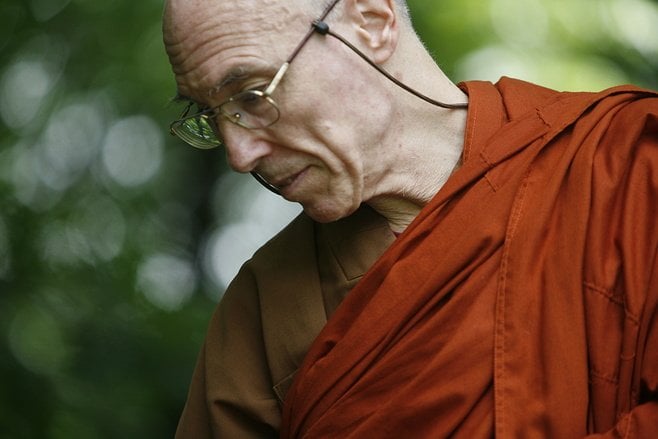
Bikkhu
Bodhi.
Bikkhu Bodhi:
Sentient Being — “Any Being with Breath”
A key element in motivation. Accidentally stepping on an insect or running over an animal on the road would not generally be in conflict with the First Precept.

Chonguri
Vegetarian Festival 2015 celebrates abstinence from meat.
Zasep Tulku Rinpoche:
“We must not hurt other people and animals.”
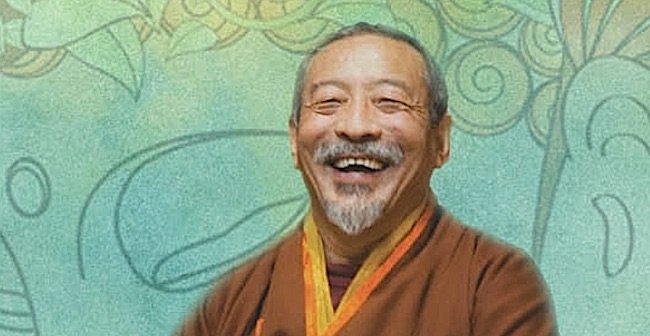
Venerable
Zasep Tulku Rinpoche is spiritual head of several Mahayana Buddhist centres in
North America and Australia.
Karma Lekshe Tsomo:
“Examine… Motivation”
The same criterion would be important in issues of “self defense” including defense of one’s country in a time of war. According to Barbara O’Brien, “some 3,000 Buddhists” serve “in the U.S. armed forces, including some Buddhist chaplains. Buddhism does not demand pacificism.” Again, however motivation is key, in this case the “motivation” of the country sponsoring the soldier. Is the action that led to killing due to the negative motivation of the country, such as greed, attachment, hatred or ignorance? [8]
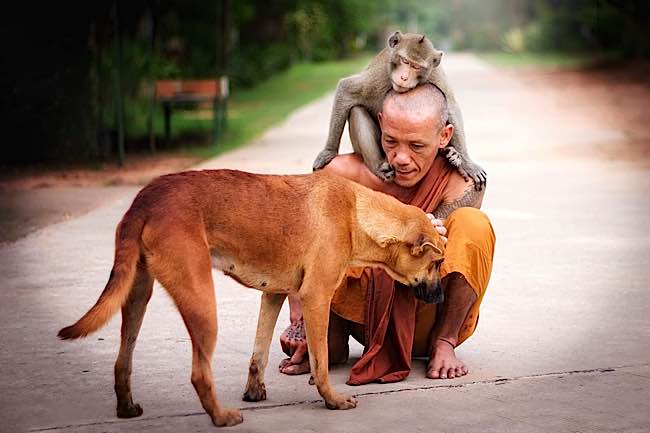
A
Buddhist monk shares a tender moment with a dog and monkey.
Thich Nhat Hanh: “No
Killing Can be Justified”
Not only is the venerable teacher a well-known pacifist activist, he is also vegetarian. “Even if we take pride in being vegetarian, for example, we have to acknowledge that the water in which we boil our vegetables contains many tiny microorganisms. We cannot be completely nonviolent, but by being vegetarian, we are going in the direction of nonviolence. If we want to head north, we can use the North Star to guide us, but it is impossible to arrive at the North Star. Our effort is only to proceed in that direction.”
Lama Zopa Rinpoche:
“Animals Experience Unbelievable Suffering”
He later described how he saw a cow struggling to not go down a ramp to slaughter: ” A man was pulling him down from the platform, but the cow didn’t want to go down. So I thought, I can’t stop the animal suffering, but what I can do as I go around the world to teach, even if it is on sutra and tantra, I will announce or request if people can become vegetarian. That is something I can do.”

Bodhisattva Vow: “Liberate All Sentient
Beings”
In sutra, sentient beings are described as all inhabitants of the three realms of samsara within the six classes of beings. Included in the six classes are animals, fish, insects — any creature with mind. Particularly as relates to the Tathagatagarbha doctrine, all these creatures have inherent Buddha Nature, “the intrinsic potential to transcend the conditions of Samsara and attain Enlightenment.” [3]

His
Holiness Khabje Chatral Sangye Dorje was an outspoken advocate of vegetarianism.
Kyabje Chatral Sangye
Dorje Rinpoche: “Meat, the sinful food.”
In Chapter 2 of “Compassionate Action” he wrote: Meat, the sinful food, is not permitted according to the three vows: the vows of individual liberation, the Bodhisattva vows and the tantric vows.” [6]
On the other hand, many Buddhists are not vegetarians. Buddha Himself taught monks to eat whatever was placed in their bowl, including meat, unless they knew the animal was slaughtered for the monks. (See “First Precept: Killing versus Eating below).
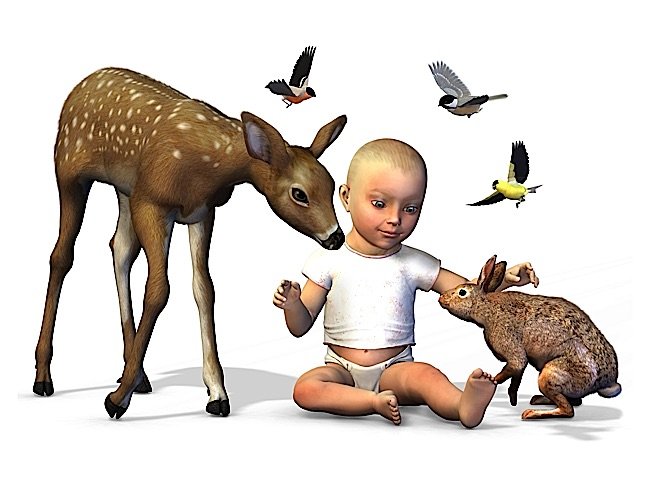
Buddha taught loving
kindness for all beings, including non-humans.
Buddha Taught Loving
Kindness — but Not Just for Humans?
There is no question that the Buddha taught loving-kindness for all sentient beings not just humans. Why is this critical? Because Buddha also taught the doctrine of rebirth — that we can be reborn as insects, lower animals, and other forms of life. Compassion for all beings, down to crawling insects, is not implicit, it appears to be explicitly recommended. This does not mean Buddhists must be vegetarians, but at least that we must feel sympathy for the suffering of all creatures.
How Equally Do We Practice Compassion?
Whether we accept the notion that we might be reborn as a future splattered insect, there can be no doubt that we are taught that our mission is to “free all sentient beings from Samsara.” How much worse is it when we, ourselves, create the causes of suffering?
First Precept: Killing versus Eating? They’re
Different Right?
Clearly, this later became an issue when monks formed communities and monasteries, where it became more difficult to argue that the animal was not killed specifically for their benefit. As devout Buddhists, the argument, therefore, comes down to whether we believe the meat on the supermarket shelf was killed for our benefit. If we believe we are not encouraging the killing, or supporting cruelty, then it would not be considered a conflict with the first precept. If we believed that by buying the meat we are supporting the slaughter of animals, we would be in conflict. Ultimately, that’s a personal choice. While meat might be debatable, what is clearly not permitted, according to this precept, is the deliberate slaughter of a sentient being, including chickens.

Geshe Thubten Soepa:
“Meat Not Allowed”

In the
Cambridge Declaration, scientists state that even an Octopus is sentient and feels
emotion.
The Cambridge
Declaration on Consciousness*
On this day of July 7, 2012, a prominent international group of cognitive neuroscientists, neuropharmacologists, neurophysiologists, neuroanatomists and computational neuroscientists gathered at The University of Cambridge to reassess the neurobiological substrates of conscious experience and related behaviors in human and non-human animals. While comparative research on this topic is naturally hampered by the inability of non-human animals, and often humans, to clearly and readily communicate about their internal states, the following observations can be stated unequivocally:
- The field of Consciousness research is rapidly evolving. Abundant new techniques and strategies for human and non-human animal research have been developed. Consequently, more data is becoming readily available, and this calls for a periodic reevaluation of previously held preconceptions in this field. Studies of non-human animals have shown that homologous brain circuits correlated with conscious experience and perception can be selectively facilitated and disrupted to assess whether they are in fact necessary for those experiences. Moreover, in humans, new non-invasive techniques are readily available to survey the correlates of consciousness.
- The neural substrates of emotions do not appear to be confined to cortical structures. In fact, subcortical neural networks aroused during affective states in humans are also critically important for generating emotional behaviors in animals. Artificial arousal of the same brain regions generates corresponding behavior and feeling states in both humans and non-human animals. Wherever in the brain one evokes instinctual emotional behaviors in non-human animals, many of the ensuing behaviors are consistent with experienced feeling states, including those internal states that are rewarding and punishing. Deep brain stimulation of these systems in humans can also generate similar affective states. Systems associated with affect are concentrated in subcortical regions where neural homologies abound. Young human and nonhuman animals without neocortices retain these brain-mind functions. Furthermore, neural circuits supporting behavioral/electrophysiological states of attentiveness, sleep and decision making appear to have arisen in evolution as early as the invertebrate radiation, being evident in insects and cephalopod mollusks (e.g., octopus).
- Birds appear to offer, in their behavior, neurophysiology, and neuroanatomy a striking case of parallel evolution of consciousness. Evidence of near human-like levels of consciousness has been most dramatically observed in African grey parrots. Mammalian and avian emotional networks and cognitive microcircuitries appear to be far more homologous than previously thought. Moreover, certain species of birds have been found to exhibit neural sleep patterns similar to those of mammals, including REM sleep and, as was demonstrated in zebra finches, neurophysiological patterns, previously thought to require a mammalian neocortex. Magpies in particular have been shown to exhibit striking similarities to humans, great apes, dolphins, and elephants in studies of mirror self-recognition.
- In humans, the effect of certain hallucinogens appears to be associated with a disruption in cortical feedforward and feedback processing. Pharmacological interventions in non-human animals with compounds known to affect conscious behavior in humans can lead to similar perturbations in behavior in non-human animals. In humans, there is evidence to suggest that awareness is correlated with cortical activity, which does not exclude possible contributions by subcortical or early cortical processing, as in visual awareness. Evidence that human and nonhuman animal emotional feelings arise from homologous subcortical brain networks provide compelling evidence for evolutionarily shared primal affective qualia.
We declare the following: “The absence of a neocortex does not appear to preclude an organism from experiencing affective states. Convergent evidence indicates that non-human animals have the neuroanatomical, neurochemical, and neurophysiological substrates of conscious states along with the capacity to exhibit intentional behaviors. Consequently, the weight of evidence indicates that humans are not unique in possessing the neurological substrates that generate consciousness. Nonhuman animals, including all mammals and birds, and many other creatures, including octopuses, also possess these neurological substrates.”
* The Cambridge Declaration on Consciousness was written by Philip Low and edited by Jaak Panksepp, Diana Reiss, David Edelman, Bruno Van Swinderen, Philip Low and Christof Koch. The Declaration was publicly proclaimed in Cambridge, UK, on July 7, 2012, at the Francis Crick Memorial Conference on Consciousness in Human and non-Human Animals, at Churchill College, University of Cambridge, by Low, Edelman and Koch. The Declaration was signed by the conference participants that very evening, in the presence of Stephen Hawking, in the Balfour Room at the Hotel du Vin in Cambridge, UK. The signing ceremony was memorialized by CBS 60 Minutes. [10]
NOTES
[2] “Buddhism and Vegetarianism“, UrbanDharma.org
[3] “Sentient Beings”
[4] “Inspired to Become a Vegetarian” Lama Zopa Rinpoche
[5] “Nine Questions About Vegetarianism” with Geshe Thubten Soepa, FPMT
[6] “Kyabje Chatral Sangye Dorje Rinpoche”
[7] “Orangutan in Argentina Wins Non Human Person Rights“, Raw Science
[8] “The First Buddhist Precept, To Abstain from Taking Life,” by Barbara O’Brien
[9] “The First Precept: Reverence for Life” by Thich Nhat Hanh
For more information about vegetarianism see http://nexusilluminati.blogspot.com/search/label/vegetarianism
- Scroll down
through ‘Older Posts’ at the end of each section
Do you like this not
for profit site?
Hours of work by a genuinely
incapacitated invalid are required every day to maintain, write, edit, research,
illustrate and publish this website from a tiny cabin in a remote forest.
Now that most people view these posts
on mobile devices, sites like this earn an ever diminishing pittance from
advertising…
Like what you see? Please give anything
you can -
Contribute any amount and receive at
least one New Illuminati eBook!
(You can use a card
securely if you don’t use Paypal)
Please click below -
Spare Bitcoin
change?
Video - https://youtu.be/W9QIOj3IYuk
For further enlightening
information enter a word or phrase into the random synchronistic search box @
the top left of http://nexusilluminati.blogspot.com
And see
New Illuminati – http://nexusilluminati.blogspot.com
New Illuminati on Facebook - https://www.facebook.com/the.new.illuminati
New Illuminati Youtube Channel - https://www.youtube.com/user/newilluminati/playlists
New Illuminati’s OWN Youtube Videos
-
New Illuminati on Google+ @ For
New Illuminati posts - https://plus.google.com/u/0/+RamAyana0/posts
New Illuminati on Twitter @ www.twitter.com/new_illuminati
New Illuminations –Art(icles) by
R. Ayana @ http://newilluminations.blogspot.com
The Her(m)etic Hermit - http://hermetic.blog.com
DISGRUNTLED SITE ADMINS PLEASE NOTE –
We provide
a live link to your original material on your site (and links via social networking
services) - which raises your ranking on search engines and helps spread your
info further!
This site
is published under Creative Commons (Attribution) CopyRIGHT (unless an
individual article or other item is declared otherwise by the copyright holder).
Reproduction for non-profit use is permitted & encouraged - if you
give attribution to the work & author and include all links in the original
(along with this or a similar notice).
Feel free
to make non-commercial hard (printed) or software copies or mirror sites - you
never know how long something will stay glued to the web – but remember
attribution!
If you
like what you see, please send a donation (no amount is too small or too large)
or leave a comment – and thanks for reading this far…
Live long
and prosper! Together we can create the best of all possible worlds…
From the New Illuminati – http://nexusilluminati.blogspot.com
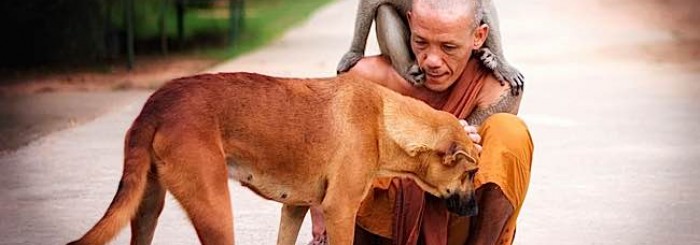
I cannot relate to this article because it totally disregards the consciousness of PLANTS.... Life lives on life, is this not a REALITY? ONE can have compassion as we EAT, just don't be a hypocrite as you choose between eating the consciousness of plants or the consciousness of animals, ALL is conscious! Our ignorance about the feelings of plants is quite profound, no?
ReplyDeleteALL consciousness is intelligent ENERGY radiation feeding one form of life to another, our opinions about which is more or less important is subjective and easily repudiated with just one finding of FACT!
DeleteNow, really ask yourselves which form of energy intelligence is most important in the web of life, as you eat?
You see.... This question is based on a faulty premise of belief that supports a notion of what you think might be real as REALITY IS what it IS, and how do we know REALITY? OPEN YOUR EYES!
In the physical realm of energy, organisms eat other organisms. That should tell us something about where our soul currently resides.
ReplyDeleteAnd yes plants do have consciousness. I encourage everyone to study that topic, as there are many scientific studies to support the assertion that plants have consciousness.
What is happening now to animals in the meat factories is utterly shameful. The level of unconsciousness in our current culture is almost unbelievable. Once a person refrains from consuming meat for awhile, the idea of eating it is abhorrent. Big chunks of bloody flesh, filled with veins and muscle tissue, how gross. People don't connect the correlation between abusing animals and their own behinds being abused. We live in a world of, for the most part, almost totally unconscious "others". It is painful indeed.
People are so big and fat now, gluttonous. Many of them look like the hogs & cows they ingest. Back in former times, when humans were very active physically or whom lived in very cold climates, like the Innuit, eating meat was more understandable. We are just currently residing in a very weird realm-the energy-physical realm. But exanding consciousness is the ticket out of here.
- I did not know about the "Cambridge Declaration". Thanks! Love you, New Illuminati!
I agree, modern day slaughterhouses are barbaric and unnecessary. The problem is, the workers have to desensitize themselves in order to work there!
DeleteJust observe how a plant turns toward the sun, FYM. This process is known as heliotropism. This is a form of consciousness, no? The pants FEEL the sun.... And yes they are VERY aware!
ReplyDeleteWe all have a choice whether or not to slaughter sentient beings and devour their corpses - and anything with a nervous system DEFINITELY feels pain.
ReplyDeleteYou don't have to kill a plant to eat its leaves, fruits or seeds, so arguments relating to plant consciousness here are irrelevant. In fact, we have been designed by plants to spread their seeds. Their awareness is of a different order.
The point is that we all have a CHOICE whether to be demonic or angelic as humans. The rest is mere gross entrained appetite and self-serving bullshit.